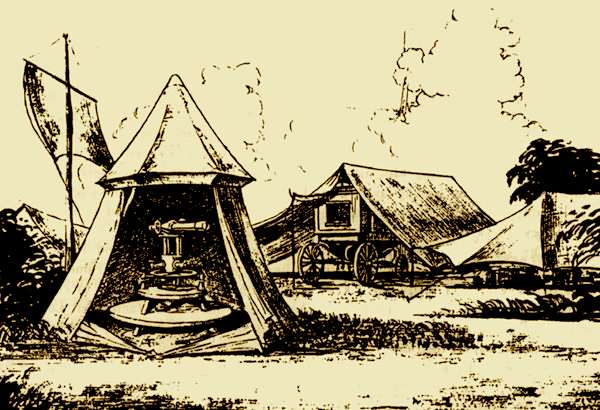 Thomas Jefferson's Theodolite
Thomas Jefferson's Theodolite Hassler's Camp
Hassler's Camp The Great Theodolite
The Great Theodolite Würdemann Six-inch Theodolite
Würdemann Six-inch Theodolite Heliotrope
Heliotrope Micrometer Scale
Micrometer Scale Theodolite Mounted on Water Tank
Theodolite Mounted on Water Tank Seven-inch Repeating Theodolite
Seven-inch Repeating Theodolite C&GS Twelve-inch Theodolite
C&GS Twelve-inch Theodolite Wild T-4
Wild T-4 K&E Theodolite, Parkhurst Design
K&E Theodolite, Parkhurst Design Wild T-2
Wild T-2 Wild T-3
Wild T-3 Topcon GPT-3002LW Total Station
Topcon GPT-3002LW Total Station
Hassler's Camp
This illustration shows what the camp of a typical survey field party might have looked like in the 1800s. In the illustration, Ferdinand Hassler's 200-pound, 24-inch theodolite sits in a tent, protected from the elements. Also visible in the background is the specially designed and reinforced carriage Hassler used to carry heavy surveying equipment.

Hand drawn image of Hassler's Camp. Image courtesy of the National Institute of Standards and Technology Virtual Museum.
The theodolite of the first Superintendent of the Survey of the Coast, Ferdinand Hassler, is the focus of this illustration of a typical survey camp in the 1800s. This theodolite weighed in at a hefty 200 pounds. Theodolites tend to be referred to by the size of their horizontal circles, so this theodolite, with its 24-inch in diameter circle, was a 24-inch theodolite.
The theodolite is set up near the specially designed carriage Hassler ordered built to carry delicate (and heavy) surveying equipment. The carriage was not only reinforced - it also contained a wine chamber and disappearing dining table. Life on a field party was evidently not all hardship!
Historic Reference
When originally established by Thomas Jefferson in 1807, the Survey of the Coast was not officially under any governmental department, but its finances were handled under the Treasury Department. In 1834, the Coast Survey was transferred to the Navy.
Records indicated that Hassler had much freer reign for purchases under the Treasury Department than within the Navy. Expense auditor Amos Kendall initially disallowed numerous expense vouchers from Hassler, including those for new equipment. Kendall stated that Hassler lacked the authority to make such purchases without prior approval.
In one instance, Hassler fumed that Kendall's objection to a recently purchased theodolite prohibited its use, "as that it does not belong to the government. If not an immediate answer to the contrary is given, F.R.H. will dispose of it, in order to return the money." Referring to previous correspondence with the Navy Department, Hassler argued that he did indeed have the authority to make the purchase and that in fact he had purchased the theodolite for half what it would cost in the U.S. However, if the purchase was not allowed, Hassler said that he was "willing to keep it, and will easily be able to dispose of it at a much enhanced price, only I must add, that in that case I have no instrument fit for my use..." No theodolite meant the work stopped "in this very moment."
Early government bureaucrats apparently had no idea what it took to perform a survey of the magnitude demanded of Hassler, and "F.R.H." battled for the best until he died in 1843 at age 73. His death, incidentally, was brought on by injuries received while trying to protect equipment during observations.
- Instrument Shown: 24-inch theodolite made by Troughton of London
- Location: New York/New Jersey area
- Manufacture Date: Approx. 1814
- Dates of Use: 1816 to approx. 1836
- Photo date: Unknown, sketch represents the early 1830s
Works Consulted
Hassler, F.R. (1820). Principle Documents Relating to the Survey of the Coast of the United States, Vol. II (pp. 22-23 and 40).
National Institute of Standards and Technology Virtual Museum. Image of Hassler's camp. Retrieved July 13, 2006.
